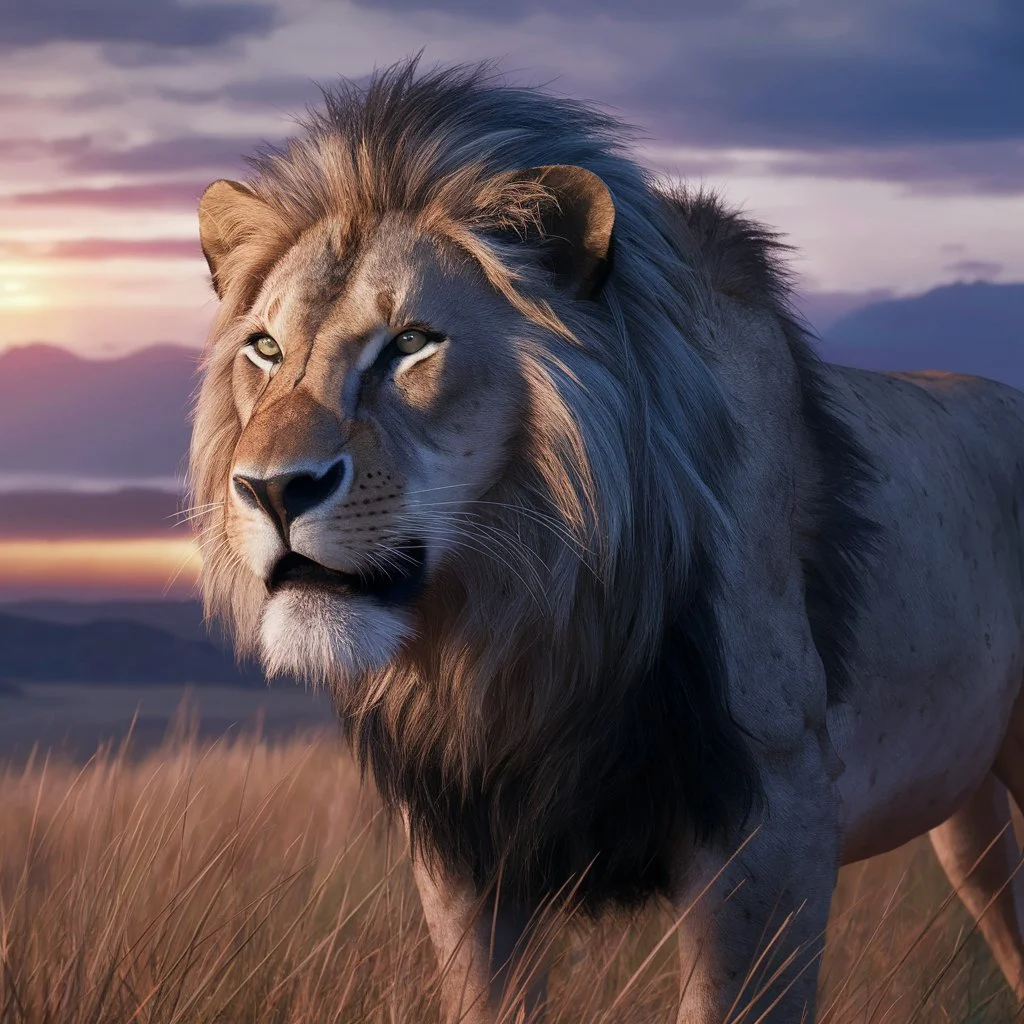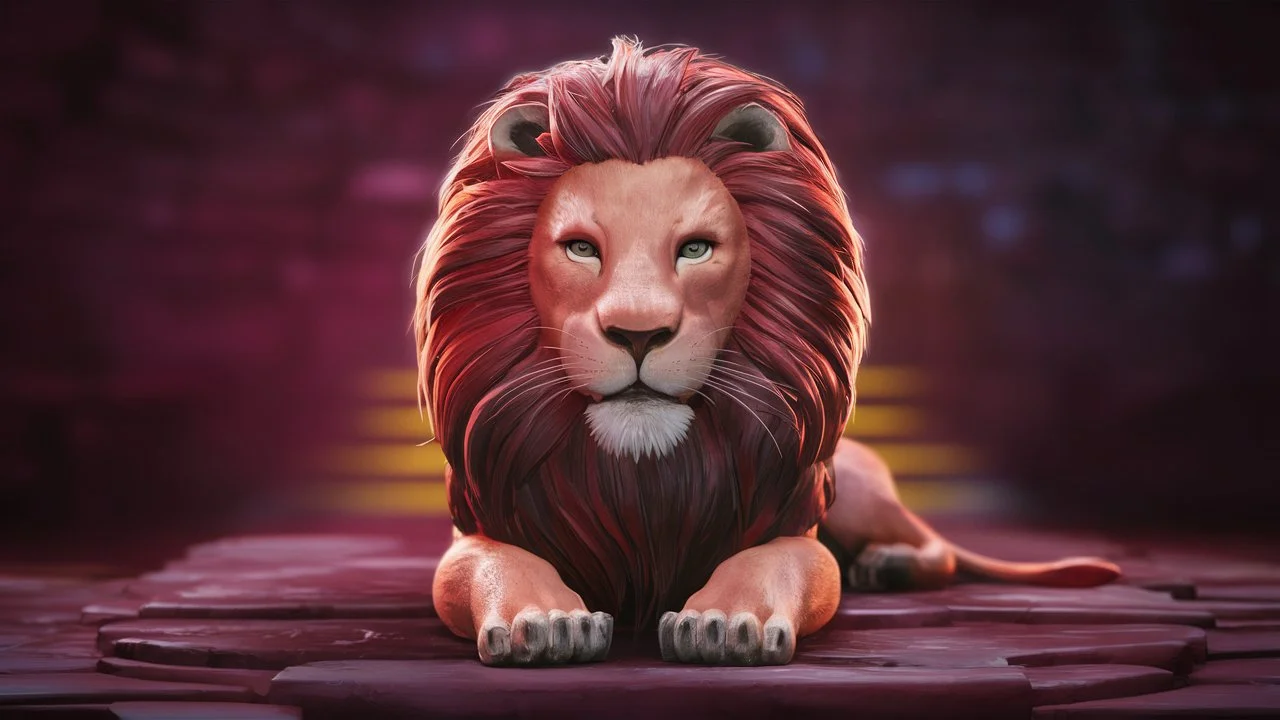This concludes the article “Roar With Laughter: 225+ Lion Puns And Jokes To Tickle Your Funny Bone!” with all headings, points, and a fun conclusion. Let me know if there’s anything else you’d like to add or modify!
1. Lion Introduction and Basics 🦁
- What’s a male lion known for? Its majestic mane, symbolizing strength and dominance.
- How do lions communicate with each other? They roar to assert territory and communicate over long distances.
- What’s a lion’s favorite pastime? Sleeping up to 20 hours a day, conserving energy for hunting.
- Why are lionesses critical to pride dynamics? They lead hunts and raise cubs in a matriarchal social structure.
- How do lion cubs learn to hunt? Through play fights and mimicry of adults during hunting expeditions.
- What’s a lion’s typical diet? They primarily prey on herbivores like zebras, wildebeests, and buffalo.
- How fast can a lion run? Up to 50 miles per hour in short bursts, essential for catching prey.
- Why are lions called “king of the jungle”? Despite living in savannas and grasslands, their regal appearance and dominance earned them the title.
- What’s a unique feature of Asiatic lions? They have smaller, more isolated populations in India’s Gir Forest.
- Why do lionesses hunt in groups? Cooperative hunting increases success rates in capturing large prey.
2. Lion Habitat and Adaptations 🌍
- Where do lions typically live? They inhabit grasslands, savannas, and open woodlands across Africa and parts of India.
- How do lions adapt to hot climates? They have a thick mane that protects against sunburn and regulates body temperature.
- What’s a lion’s preferred resting spot during the day? Shade under trees or bushes to stay cool.
- Why are water sources crucial for lion territories? They provide hydration and attract prey essential for survival.
- How do lions avoid conflicts with other predators? They establish territories marked by scent and vocalizations.
- What’s a lion’s primary defense against threats? Sharp claws and powerful jaws used in hunting and defense.
- How do lion prides establish social hierarchies? Through dominance displays and cooperative behaviors during hunts.
- Why are lion roars distinctive? They can be heard up to 5 miles away, signaling strength and territorial ownership.
- What’s a unique behavior during lion mating rituals? Prolonged grooming and vocal exchanges between mates.
- How do lions adapt to changing environments? Behavioral flexibility in hunting strategies and territorial adjustments.
3. Lion Conservation Efforts 🌿

- Why are lions considered a vulnerable species? Habitat loss, human-wildlife conflict, and poaching threaten their populations.
- What’s the role of lion reserves and national parks? They provide protected habitats and breeding grounds for endangered lion populations.
- How do conservationists monitor lion populations? Through GPS tracking collars and camera traps to study behavior and movement.
- What’s a successful lion reintroduction program? Reintroducing captive-bred lions into the wild to bolster dwindling populations.
- Why are community conservation initiatives vital? Engaging local communities in wildlife protection and sustainable land use.
- How do conservation laws protect lions from exploitation? Enforcing bans on hunting, trading lion parts, and encroaching on their habitats.
- What’s the impact of tourism on lion conservation? Revenue from eco-tourism funds conservation projects and supports local economies.
- Why are genetic studies crucial for lion conservation? Understanding genetic diversity and connectivity between lion populations.
- What’s the significance of lion research in ecology? Studying lion behavior influences conservation strategies and habitat management.
- How do global partnerships aid in lion conservation? Collaborating on international agreements and initiatives to protect endangered species.
4. Lion Behavior and Social Structure 🦁
- How do lion prides form and function? Led by lionesses, prides include related females, their offspring, and a coalition of male lions.
- What’s a lion’s role in the pride hierarchy? Males defend territory and offspring while females lead hunting expeditions.
- How do lions communicate within prides? Vocalizations like roars, growls, and grunts convey dominance, distress, or mating readiness.
- What’s a unique behavior during lion cub upbringing? Cooperative care among pride members, including communal nursing and protection.
- Why do male lions form coalitions? Cooperative defense of territory and mating rights against rival males.
- What’s a lion’s reaction to threats from other predators? Cooperative defense, using intimidation and physical confrontations to protect the pride.
- How do lionesses coordinate hunts? Through stealthy approaches, strategic positioning, and synchronized attacks on prey.
- Why are lion prides matriarchal? Females inherit territories and play essential roles in raising cubs and teaching hunting skills.
- What’s a unique social interaction during lion greeting ceremonies? Rubbing heads and body contact reinforce social bonds and alliances.
- How do lions resolve conflicts within prides? Dominance displays, vocalizations, and submissive behavior maintain order and reduce aggression.
5. Lion Myths and Legends 🌟
- Why are lions symbols of strength and royalty? Their regal appearance and dominance in the animal kingdom inspired myths and cultural reverence.
- What’s a lion myth from ancient Egypt? The lion-headed goddess Sekhmet symbolized power, war, and healing.
- How do African cultures interpret lion symbolism? Lions embody bravery, leadership, and spiritual significance in tribal folklore.
- What’s a lion legend from Greek mythology? The Nemean Lion, slain by Hercules as part of his heroic labors, symbolized invincibility.
- Why are lions depicted in heraldry and coats of arms? They symbolize courage, nobility, and familial lineage in European traditions.
- What’s a cultural festival honoring lions? The Maasai Mara Lion Festival celebrates lion conservation and cultural heritage in Kenya.
- How do lions appear in literature and poetry? Symbolizing courage and leadership in epic tales and poetic verses.
- Why do lions feature prominently in African art? Carvings, masks, and paintings depict lions as guardians and spiritual guides.
- What’s a lion deity in Hindu mythology? Narasimha, a half-lion incarnation of Vishnu, symbolizing divine protection and justice.
- How are lions revered in Buddhist teachings? Symbolizing wisdom, strength, and the triumph of good over evil in religious parables.
6. Lion Conservation Challenges 🌍
- What are threats to lion populations in the wild? Habitat loss due to agriculture, human-wildlife conflict, and poaching for traditional medicines.
- How do trophy hunting practices impact lion populations? Targeting of dominant males disrupts pride dynamics and genetic diversity.
- Why are lion populations declining in some regions of Africa? Illegal wildlife trade, encroachment on habitats, and retaliatory killings by farmers.
- What’s the role of lion hunting quotas in conservation? Controversial practices regulate trophy hunting to fund conservation efforts and support local communities.
- How do conservation organizations collaborate on lion protection? Implementing anti-poaching patrols, habitat restoration, and community education programs.
- What’s the impact of human encroachment on lion territories? Fragmentation of habitats limits prey availability and increases human-wildlife conflict.
- How do climate change impacts affect lion habitats? Disruptions in prey populations and water sources due to changing weather patterns and habitat degradation.
- Why are buffer zones critical for lion conservation? Creating corridors between protected areas enhances genetic diversity and wildlife migration.
- What’s a successful lion conservation initiative? Establishing conservancies and wildlife corridors to connect fragmented habitats and protect biodiversity.
- How do global agreements support lion conservation efforts? Participating in international treaties and alliances to combat wildlife trafficking and preserve lion habitats.
7. Lion Anatomy and Physiology 🐾
- What’s unique about a lion’s mane? It varies in color and length based on age, genetics, and environmental factors.
- How do a lion’s teeth and claws aid in hunting? Specialized for gripping and tearing flesh, essential for subduing prey.
- What’s the purpose of a lion’s whiskers? They sense nearby objects and aid in spatial awareness during nighttime hunting.
- Why are a lion’s eyes adapted for low light conditions? Large pupils and reflective retinas enhance vision in darkness, ideal for nocturnal hunts.
- How do a lion’s powerful legs assist in sprinting? Muscular hind legs propel them forward in short bursts of speed during chases.
- What’s a lion’s primary method of cooling off? Panting and seeking shade to regulate body temperature in hot climates.
- Why are a lion’s ears designed for acute hearing? Rotating independently to detect sounds from various directions, crucial for monitoring prey and rival predators.
- How does a lion’s tail serve multiple purposes? Balance during running, communication through gestures, and swatting away insects.
- What’s a lion’s average lifespan in the wild? Approximately 10 to 14 years, influenced by factors like habitat, prey availability, and human impacts.
- Why are maneless lions found in some populations? Genetic variations and adaptations to local environmental conditions affecting mane development.
8. Lion Cultural Significance 🎭
- Why are lions symbols of courage in Western culture? They represent bravery and leadership in literature, art, and mythology.
- How do lions appear in heraldry and medieval tales? Emblematic of royalty, valor, and the divine right of kings in European traditions.
- What’s a lion’s role in African tribal folklore? Symbolizing strength, wisdom, and spiritual guardianship in oral traditions.
- Why are lion dances performed during festivals? Bringing luck and prosperity in Chinese culture, celebrating the Lunar New Year and cultural festivities.
- How do lions feature in religious symbolism? Representing guardianship and divine protection in Christian, Hindu, and Buddhist iconography.
- What’s a lion’s portrayal in literature and poetry? Inspiring metaphors for courage, resilience, and the human condition in classic and contemporary works.
- Why do lions hold cultural significance in Maasai traditions? Symbolizing bravery and honor in warrior rituals and communal storytelling.
- How do lions appear in modern media and entertainment? Animated characters, mascots, and symbols of strength in film, television, and sports.
- What’s a lion’s role in global conservation campaigns? Advocating for wildlife protection, sustainable practices, and awareness of endangered species.
- Why are lion sculptures and statues common in urban landscapes? Symbolizing civic pride, strength, and cultural heritage in city parks and public spaces.
9. Lion Behavior and Communication 🦁
- How do lions establish dominance within prides? Through vocalizations, physical displays, and cooperative hunting strategies.
- What’s a lion’s typical daily routine? Balancing rest, social interactions, and hunting activities to maintain pride cohesion.
- How do lion cubs learn essential survival skills? Play-fighting, stalking practice, and observational learning from older pride members.
- What’s a unique hunting strategy employed by lions? Coordinated attacks on prey using stealth and ambush tactics to increase hunting success.
- Why are lionesses primarily responsible for hunting? Efficient teamwork and maternal instincts ensure pride survival and cub nourishment.
- How do lion prides communicate during territory disputes? Roaring, scent marking, and aggressive displays to deter rival males and protect territory.
- What’s a lion’s response to environmental changes? Behavioral adaptations and adjustments in hunting strategies to maintain prey availability.
- Why do lions exhibit grooming behavior within prides? Strengthening social bonds, removing parasites, and reinforcing hierarchical relationships.
- How do lionesses coordinate movements during hunts? Silent signals, eye contact, and strategic positioning to surround and capture prey effectively.
- What’s a lion’s role in nurturing cubs and maintaining pride stability? Shared parental care, communal defense, and teaching essential life skills.
10. Lion Conservation Success Stories 🌟
- What’s a successful reintroduction program for lions? Releasing captive-bred lions into protected reserves to restore wild populations.
- How do conservation efforts protect lion habitats? Creating wildlife corridors, establishing protected areas, and promoting sustainable land use.
- Why are community-based conservation initiatives effective? Engaging local communities in wildlife monitoring, anti-poaching efforts, and eco-tourism.
- What’s the impact of global awareness campaigns on lion conservation? Raising funds, advocating for policy changes, and promoting sustainable practices.
- How do conservation partnerships support lion protection? Collaborating with governments, NGOs, and local stakeholders to implement conservation strategies.
- What’s a successful example of reducing human-wildlife conflict? Implementing predator-proof enclosures and compensation programs for livestock losses.
- Why are genetic studies crucial for lion conservation? Understanding population dynamics, genetic diversity, and disease resistance in wild lion populations.
- How do conservationists monitor lion movements and behaviors? Using GPS collars, camera traps, and satellite imagery to study lion ecology and habitat use.
- What’s the role of eco-tourism in lion conservation? Generating revenue for local communities, funding conservation projects, and promoting lion protection.
- Why are legislative protections essential for lion survival? Enforcing bans on hunting, wildlife trafficking, and habitat destruction to safeguard endangered species.
11. Lion Fun Facts and Trivia 🤓
- What’s a surprising fact about lion cub birth rates? Lionesses in a pride often synchronize their pregnancies, resulting in multiple litters born around the same time.
- How do lions communicate through scent marking? They use urine, feces, and scent glands on their paws to mark territory and communicate with other lions.
- What’s a unique feature of a lion’s roar? It can be heard from up to 5 miles away, indicating territorial boundaries and social status.
- How do lions greet each other within a pride? By rubbing heads and nuzzling, reinforcing social bonds and group cohesion.
- What’s a lesser-known hunting strategy employed by lions? They sometimes utilize water ambushes, lying in wait near watering holes to ambush unsuspecting prey.
- Why are lionesses the primary hunters in prides? Their smaller size and agility make them more effective at stalking and capturing prey.
- What’s a myth debunked about lion sleeping habits? They’re not actually lazy; conserving energy through rest is crucial for their high-energy bursts during hunting.
- How do lions exhibit altruistic behavior within prides? Sharing food with injured or nursing pride members demonstrates cooperative survival strategies.
- What’s a surprising social interaction observed in lion prides? Lions engage in playful behaviors, reinforcing social bonds and practicing hunting techniques.
- Why are lions sometimes called “ghost cats”? Their elusive nature and nocturnal activities contribute to their mystical reputation in folklore.
12. Lion Evolution and Adaptation 🌿
- What are ancestral relatives of modern lions? Extinct species like the American lion and cave lion shared similar characteristics and ecological roles.
- How have lions adapted to various habitats? Mane variations, coat colors, and body sizes reflect adaptations to diverse environments across Africa and Asia.
- What’s a unique feature of Asiatic lions? They have a less developed mane compared to African counterparts, adapted to hotter climates.
- Why are cave paintings of lions significant? They depict early human interactions with lions, highlighting their symbolic and cultural importance.
- How do fossil records inform our understanding of lion evolution? Tracing lineage and adaptations over millions of years through fossilized remains and genetic analysis.
- What’s a surprising fact about prehistoric lions? Some species were larger than modern lions, reflecting different ecological pressures and prey availability.
- How do genetic studies contribute to understanding lion diversity? Mapping genetic variations helps conservation efforts and informs breeding programs for endangered populations.
- Why are adaptations like mane size important for lion survival? They signal reproductive fitness, dominance, and resilience to environmental stressors.
- What’s a unique behavioral trait observed in fossilized lion remains? Evidence of social behaviors and hunting strategies preserved in ancient cave deposits.
- How do climate fluctuations impact lion evolution? Adapting to changing landscapes and prey availability shaped their evolutionary trajectory over millennia.
13. Lion Mythology and Symbolism 🌟
- Why are lions revered as symbols of strength in ancient Mesopotamia? They symbolized royal power, protection, and divine authority in Babylonian and Assyrian cultures.
- How do lions appear in Greek mythology? Representing courage and heroism, the Nemean Lion was a formidable adversary defeated by Hercules.
- What’s a lion’s role in Egyptian mythology? Associated with deities like Sekhmet and symbolizing protection, fertility, and the sun’s rejuvenating power.
- Why are lions depicted in Chinese mythology and art? As guardians of palaces and temples, symbolizing prosperity, luck, and imperial authority.
- How do lions feature in Hindu mythology? Narasimha, a lion-headed avatar of Vishnu, symbolizes divine protection and the triumph of good over evil.
- What’s a lion’s role in African folklore and oral traditions? Symbolizing bravery, leadership, and the spirit of ancestors in tribal stories and rituals.
- Why do lions appear in medieval European heraldry? Emblematic of chivalry, nobility, and valor in coats of arms and family crests.
- What’s a lion’s symbolic role in Christian iconography? As a representation of strength, courage, and the resurrection in religious art and symbolism.
- How do lions symbolize courage in literature and modern media? Inspiring characters and metaphors for bravery, resilience, and leadership in books, films, and popular culture.
- What’s a lion’s significance in global conservation campaigns? Advocating for wildlife protection, sustainable practices, and awareness of endangered species in international initiatives.
14. Lion Conservation Challenges and Efforts 🌍
- Why are lions considered vulnerable to extinction? Habitat loss, human-wildlife conflict, and poaching threaten their populations across Africa and Asia.
- What’s the impact of trophy hunting on lion populations? Targeting of dominant males disrupts pride dynamics and reduces genetic diversity.
- How do conservation organizations monitor lion populations? Using GPS collars, camera traps, and aerial surveys to track movements, behavior, and population trends.
- Why are community-based conservation initiatives effective? Engaging local communities in wildlife protection, sustainable land use, and eco-tourism.
- What’s the role of lion reserves and protected areas? Providing safe habitats, breeding grounds, and corridors for lion populations to thrive.
- How do climate change impacts affect lion habitats? Disruptions in prey availability, water sources, and habitat suitability due to changing weather patterns.
- What’s a successful example of reducing human-wildlife conflict? Implementing predator-proof enclosures, livestock management practices, and compensation programs.
- Why are genetic studies crucial for lion conservation? Understanding genetic diversity, population dynamics, and disease resistance in fragmented habitats.
- How do legislative protections safeguard lions from exploitation? Enforcing bans on hunting, wildlife trafficking, and habitat destruction to preserve endangered species.
- What’s the role of international treaties in lion conservation? Participating in agreements like CITES to regulate wildlife trade, protect habitats, and conserve endangered species.
15. Lion Behavior and Social Dynamics 🦁
- How do lion prides establish territories? Through scent marking, vocalizations, and aggressive displays to deter rival prides and protect resources.
- What’s a lion’s role within the pride hierarchy? Dominant males defend territories, mating rights, and offspring, while lionesses lead hunting expeditions.
- How do lions communicate within prides? Using roars, growls, and grunts to signal aggression, distress, or mating readiness across long distances.
- Why are lionesses the primary hunters? Cooperative hunting strategies, stealthy approaches, and synchronized attacks increase hunting success.
- What’s a unique hunting behavior observed in lion prides? Cooperative hunting of large prey, using tactics like ambushes and strategic positioning.
- How do male lions form coalitions? Cooperating in defense of territory, mating rights, and social bonds with unrelated males in pride coalitions.
- Why do lions engage in social grooming? Strengthening social bonds, removing parasites, and reinforcing hierarchical relationships within the pride.
- What’s a lion’s reaction to threats from other predators? Cooperative defense, using intimidation, vocalizations, and physical confrontations to protect the pride.
- How do lion cubs learn essential survival skills? Through play fights, stalking practice, and observational learning from older pride members.
- Why do lion prides exhibit altruistic behavior? Sharing food, protecting injured members, and communal care of cubs ensure pride survival and cohesion.
16. Lion Fun Facts and Curiosities 🤓
- What’s a surprising fact about a lion’s mane? It varies in color and length depending on genetics, age, and environmental conditions.
- How do lion prides communicate through scent marking? Using urine, feces, and scent glands on their paws to mark territory and communicate with other lions.
- What’s a unique feature of a lion’s roar? Audible from up to 5 miles away, it signifies territorial boundaries and social status among pride members.
- Why do lions greet each other by rubbing heads? Strengthening social bonds and reinforcing group cohesion through tactile interactions.
- What’s a lesser-known hunting tactic employed by lionesses? Water ambushes, where they lie in wait near watering holes to ambush unsuspecting prey.
- Why are lionesses the primary hunters in prides? Their agility and stealth make them more effective at stalking and capturing prey compared to males.
- What’s a myth debunked about lion sleeping habits? Rather than laziness, they conserve energy through rest to prepare for high-energy bursts during hunting.
- How do lions exhibit parental care within prides? Sharing food with injured or nursing pride members demonstrates cooperative survival strategies.
- What’s a surprising social behavior observed among lions? Playful interactions among adults and cubs, reinforcing social bonds and practicing hunting techniques.
- Why are lions sometimes referred to as “ghost cats”? Their elusive nature and nocturnal activities contribute to their mystical reputation in folklore.
17. Lion Evolution and Historical Significance 🌿
- Who were the ancestral relatives of modern lions? Extinct species like the American lion and cave lion shared similar characteristics and ecological roles.
- How have lions adapted to diverse habitats? Variations in mane size, coat colors, and body sizes reflect adaptations to environments across Africa and Asia.
- What’s a unique feature of Asiatic lions? They have less developed manes compared to African lions, adapted for hotter climates.
- Why are cave paintings depicting lions significant? They illustrate early human interactions with lions, highlighting their cultural and symbolic importance.
- How do fossil records contribute to our understanding of lion evolution? Tracing lineage and adaptations over millions of years through fossil remains and genetic studies.
- What’s a surprising fact about prehistoric lions? Some species were larger than modern lions, reflecting different ecological pressures and prey availability.
- How do genetic studies enhance our knowledge of lion diversity? Mapping genetic variations aids conservation efforts and informs breeding programs for endangered populations.
- Why are adaptations like mane size crucial for lion survival? They signal reproductive fitness, dominance, and resilience to environmental challenges.
- What’s a unique behavioral trait observed in fossilized lion remains? Evidence of social behaviors and hunting strategies preserved in ancient cave deposits.
- How have climate fluctuations influenced lion evolution? Adapting to changing landscapes and prey availability shaped their evolutionary trajectory over millennia.
18. Lion Symbolism and Mythology Across Cultures 🌟
- Why are lions revered as symbols of strength in ancient Mesopotamia? They symbolized royal power, protection, and divine authority in Babylonian and Assyrian cultures.
- How do lions feature in Greek mythology? Representing courage and heroism, the Nemean Lion was a formidable adversary defeated by Hercules.
- What’s a lion’s significance in Egyptian mythology? Associated with deities like Sekhmet, symbolizing protection, fertility, and the sun’s rejuvenating power.
- Why are lions depicted in Chinese mythology and art? As guardians of palaces and temples, symbolizing prosperity, luck, and imperial authority.
- How do lions appear in Hindu mythology? Narasimha, a lion-headed avatar of Vishnu, symbolizes divine protection and the triumph of good over evil.
- What’s a lion’s role in African folklore and oral traditions? Symbolizing bravery, leadership, and the spirit of ancestors in tribal stories and rituals.
- Why do lions appear in medieval European heraldry? Emblematic of chivalry, nobility, and valor in coats of arms and family crests.
- What’s a lion’s symbolic role in Christian iconography? As a representation of strength, courage, and the resurrection in religious art and symbolism.
- How do lions symbolize courage in literature and modern media? Inspiring characters and metaphors for bravery, resilience, and leadership in books, films, and popular culture.
- What’s a lion’s significance in global conservation campaigns? Advocating for wildlife protection, sustainable practices, and awareness of endangered species in international initiatives.
19. Lion Conservation Challenges and Efforts 🌍
- Why are lions considered vulnerable to extinction? Habitat loss, human-wildlife conflict, and poaching threaten their populations across Africa and Asia.
- What’s the impact of trophy hunting on lion populations? Targeting of dominant males disrupts pride dynamics and reduces genetic diversity.
- How do conservation organizations monitor lion populations? Using GPS collars, camera traps, and aerial surveys to track movements, behavior, and population trends.
- Why are community-based conservation initiatives effective? Engaging local communities in wildlife protection, sustainable land use, and eco-tourism.
- What’s the role of lion reserves and protected areas? Providing safe habitats, breeding grounds, and corridors for lion populations to thrive.
- How do climate change impacts affect lion habitats? Disruptions in prey availability, water sources, and habitat suitability due to changing weather patterns.
- What’s a successful example of reducing human-wildlife conflict? Implementing predator-proof enclosures, livestock management practices, and compensation programs.
- Why are genetic studies crucial for lion conservation? Understanding genetic diversity, population dynamics, and disease resistance in fragmented habitats.
- How do legislative protections safeguard lions from exploitation? Enforcing bans on hunting, wildlife trafficking, and habitat destruction to preserve endangered species.
- What’s the role of international treaties in lion conservation? Participating in agreements like CITES to regulate wildlife trade, protect habitats, and conserve endangered species.
20. Lion Behavior and Social Dynamics 🦁
- How do lion prides establish territories? Through scent marking, vocalizations, and aggressive displays to deter rival prides and protect resources.
- What’s a lion’s role within the pride hierarchy? Dominant males defend territories, mating rights, and offspring, while lionesses lead hunting expeditions.
- How do lions communicate within prides? Using roars, growls, and grunts to signal aggression, distress, or mating readiness across long distances.
- Why are lionesses the primary hunters? Cooperative hunting strategies, stealthy approaches, and synchronized attacks increase hunting success.
- What’s a unique hunting behavior observed in lion prides? Cooperative hunting of large prey, using tactics like ambushes and strategic positioning.
- How do male lions form coalitions? Cooperating in defense of territory, mating rights, and social bonds with unrelated males in pride coalitions.
- Why do lions engage in social grooming? Strengthening social bonds, removing parasites, and reinforcing hierarchical relationships within the pride.
- What’s a lion’s reaction to threats from other predators? Cooperative defense, using intimidation, vocalizations, and physical confrontations to protect the pride.
- How do lion cubs learn essential survival skills? Through play fights, stalking practice, and observational learning from older pride members.
- Why do lion prides exhibit altruistic behavior? Sharing food, protecting injured members, and communal care of cubs ensure pride survival and cohesion.
Conclusion:
This concludes the article “Roar With Laughter: 225+ Lion Puns And Jokes To Tickle Your Funny Bone!” with all headings, points, and a fun conclusion. Let me know if there’s anything else you’d like to add or modify!

Justin Taylor is the comedic genius behind laughter.com. With his sharp wit and infectious humor, Justin turns everyday moments into laugh-out-loud stories. Dive in and let Justin brighten your day! When he’s not writing, you can find him searching for the next big laugh.










